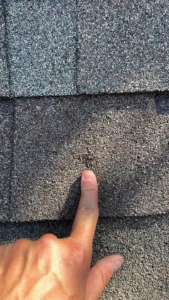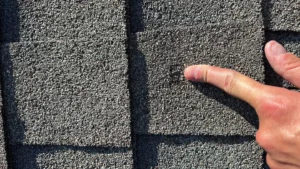Posted on Thursday, September 28th, 2023 at 11:49 am
Hailstorms can be a homeowner’s worst nightmare, causing significant property damage, especially your roof. Quickly detecting hail damage is crucial to prevent more extensive and costly repairs. In this blog, we will guide you through what to look for when inspecting your roof for hail damage and why it’s essential to address it promptly.
Steps to Identifying Hail Damage
 You should always talk about possible hail damage repairs to your roof with an experienced roofer. They will know the signs and can make a plan of action with you to get it taken care of. However, these are the steps you should take to assess the hail damage on your own:
You should always talk about possible hail damage repairs to your roof with an experienced roofer. They will know the signs and can make a plan of action with you to get it taken care of. However, these are the steps you should take to assess the hail damage on your own:
1. Start with a Visual Inspection
After a hailstorm, the first step is to visually inspect your roof. Here’s what to look for:
- Dented or Damaged Shingles: Hail damage often manifests as dented, bruised, or cracked shingles. These can be challenging to spot from the ground, so use binoculars or, if safe, climb a ladder for a closer look.
- Granule Loss: Check for granules collecting in your gutters or downspouts. Hail can dislodge these granules from shingles, leaving them more vulnerable to UV rays and further damage.
- Indentations: Hail can leave indentations on metal or asphalt roofs. These may be subtle and require close inspection to detect.
- Damaged Flashing: Inspect the metal flashing around roof penetrations like chimneys, vents, and skylights. Hail can cause dents and cracks in these areas.
2. Inspect Gutters and Downspouts
Your gutters and downspouts can provide clues about hail damage:
- Gutter Dings: Check for dings or dents in your gutters and downspouts, which may indicate hail impact.
- Excessive Granules: If you find excessive granules in your gutters, it’s a sign that your roof may have suffered hail damage.
3. Look for Cracks in Skylights and Vents
Skylights, vents, and other roof penetrations are susceptible to hail damage. Inspect them for:
- Cracks or Breaks: Hail can cause cracks or breaks in plastic or glass skylights and vent covers.
- Dented Flashing: Examine the metal flashing around these penetrations for dents or damage.
4. Check the Siding and Exterior
Hail damage isn’t limited to the roof. It can also affect your home’s siding and exterior:
- Dents or Pockmarks: Inspect your siding for dents, pockmarks, or chipped paint that may result from hail impact.
- Window Damage: Check your windows for cracks or chips in the glass.
5. Consult a Professional
 While you can perform a preliminary inspection, talking to a professional roofing contractor for a complete assessment is essential. They have the expertise and experience to identify hail damage that might not be immediately visible to the untrained eye.
While you can perform a preliminary inspection, talking to a professional roofing contractor for a complete assessment is essential. They have the expertise and experience to identify hail damage that might not be immediately visible to the untrained eye.
6. Why Prompt Action Matters
Promptly addressing hail damage is vital for several reasons:
- Preventing Further Damage: Hail damage can compromise the integrity of your roof, leading to leaks and more extensive issues if left untreated.
- Insurance Claims: Many insurance policies cover hail damage. Promptly addressing it and documenting the damage can simplify the insurance claims process.
- Preserving Your Investment: Your roof is an investment in your home. Timely repairs or replacements protect that investment and extend your roof’s lifespan.
Contact the Hail Damage Experts at Roofsonly.com
Hail damage is not always obvious, but it can positively impact the longevity and functionality of your roof. Regular inspections, especially after severe weather events, are crucial to identifying hail damage early. If you suspect hail damage or want a professional assessment, don’t hesitate to contact a skilled roofing contractor. Timely repairs can save you money and provide peace of mind that your home is well-protected. Call our team today at (737) 275-7599 to schedule a free estimate. Roofsonly.com has years of experience helping families like yours.
Related Posts:

